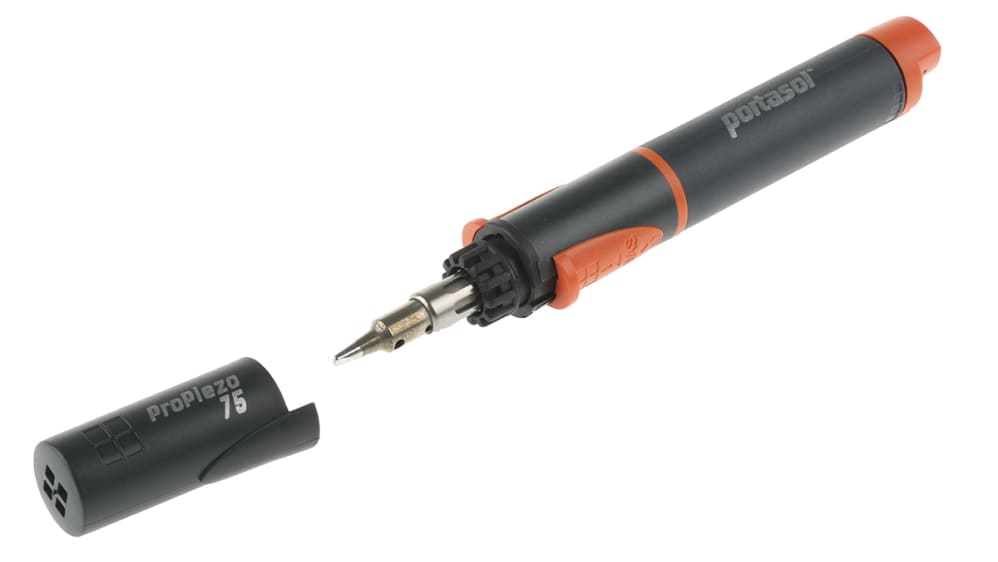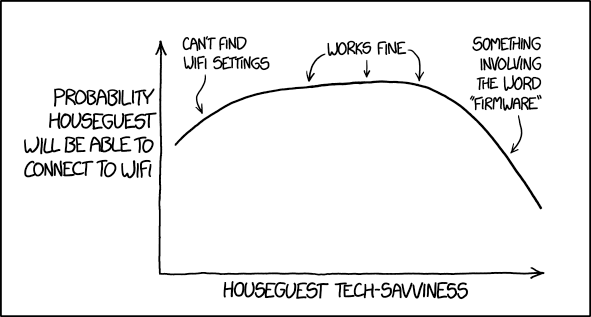There are gas powered soldering irons that are essentially lighters with metal around the flame. Real life savers

There are also battery powered soldering irons.
I like the pinecil, usb-c powered soldering iron with temperature control. If you are not doing anything intensive any fast smartphone charger will power it.
I’ve had mine running off of a power bank before too.
My TS101 doesn’t really work with a phone charger, I use the laptop’s or a power bank
Depends on the charger and or cable. Might not support the right protocol or just be weird when it should work.
yes but that sounds boring and doesn’t require having a functionally super-hot piece right near a reserve of acetylene.
Yes, and they actually have a working thermostat, so they aren’t complete garbage to solder electronics with.
Gas powered soldering irons are great for soldering stuff like copper water pipes. But even soldering through-hole components with them is a pain in the ass due to the temperature instantly evaporating all your flux. Soldering SMD components is near impossible with them
It’s only stupid if it doesn’t work
And vice versa
Yeah! “It’s only doesn’t work if it stupid.” 🤷♂️ I’ve always said that…
It’s only work if it doesn’t stupid.
Should have just left it in, and been able to get the soldering done twice as fast.
New manufacturing hack unlocked: Install 240v outlets at workstations and fire half of the workforce. Golden parachute and douchey, hand-wavey TED Talk, please!
Elon knows more about manufacturing than any other person on earth, he said
there’s the STEM bell curve. XKCD shows the axes as ‘how well your computer works’ vs ‘how well you know computers’. that is accurate.
but if you’ve ever known serious engineers who didn’t just live boring white collar work-home-work-and-some-marvel-shit lives, you’ll have seen things that make this look mild.
edit: and it gets really crazy when you’re talking about a civil engineer. closest thing you’ll ever find to an eldritch location.
I think there’s another one, where the right side references operating systems, and another without the graph that’s along similar lines. long runners sometimes return to the same wells, I guess.
Link?
no, sorry; I’m profoundly lazy.
deleted by creator
I have my incredibly rare moments. yes.
Finally, an usecase for USB irons!
I just got one, and it’s so practical with a PD battery bank. Can now solder inside or outside on my car/bike with zero hazzle
I have one too, I like the idea of it but can’t solder with it. For any serious work I use my old transformer iron that has enough power to melt the solder.
Sure, a Weller station will probably last a lifetime even with serious usage, but I do maybe…. 20 total solder joint per year, so I couldn’t justify the price.
I do agree that it’s better at what it’s supposed to do though
Not quite a Weller station, but also will last a lifetime ;)

Edit: I’m aware that USB irons are good and I’m just shit at using them
I really appreciate that you took the time to take a photo to show us your iron. It’s nice to get the more personal touch as I keep forgetting we are real people talking together.
It looks like an old clenodium. I’m sure it has seen its fair share of work. Thanks for sharing!
Don’t they have switches?
Sounds like a cheap portable soldering iron, which just heats up to some roughly usable temperature whenever it’s plugged in.
Textbook definition!
Ive seen some really cheap irons that have zero controls, you plug them in and they operate at max power. Basically a wood burning pencil, really.
An engineer that has a project to show off at a trade show will have will have both a power switch and a temperature control on their soldering iron.
I’m an engineer that’s been in that sort of situation. If it’s planned, you have the tools. Unfortunately, sometimes these things happen and it’s not planned. At that point it’s taken what you can get. A cheap fire stick will still do the job better than no fire stick.
Every one i’ve owned has and I get the cheap ones. I guess you can find them for under a dollar or something
I’ve only seen outlet switches in the UK, unless you plugged into a roof lamp outlet where the switch are by the entrance door, but then you need a plug like these (at least here in sweden)

I’ve had a similar experience as a child. I live in Germany and found this voltage switch on a hair dryer. My thoughts were like: Switching it to less couldn’t possibly hurt, could it? Well it could. It was super efficient though but only for a few seconds before it self destructed.
They need a 1/4 duty cycle.
Person Wait Modulation.
I had the opposite problem, I brought a soldering iron from Europe to Canada, and despite using a step up transformer, it just couldn’t get hot enough to melt the solder!
You should have used 200% duty cycle
Splice on a second plug, so you can use two outlets at the same time.
(/s, mostly… this can actually work, if you can find two outlets on opposite phases.)
There’s an actual commercial product that does this. It even meets UL and CSA standards.
But it wouldn’t be 200%, it would be something like 170% power assuming 3 phases, right. Too lazy to do the math.
You’re correct, phase-to-phase is 173.2% of the phase-to-neutral voltage in 3-phase “Wye” service.
But that’s not what consumers (typically) use in North America. We don’t bring three phase to the home.
Our single-phase final distribution transformers have a center tap on the secondary coil, bonded to neutral. So, one side of the coil provides a 120v leg with respect to that neutral, and the other side provides an opposing leg, 180° from the first, and 120v with respect to that same neutral. Most of our appliances use leg-to-neutral, 120v. But leg-to-leg is 240v.
(Commercial and industrial facilities can get a wide variety of voltages in single or three phase, and we do have some actual, 2-phase generators and customers: the phases are 90° apart rather than 120° or 180°)
The technology connections video talking about 240v power mentioned some apartment buildings having 208v because they’re bringing in two phases instead of center tapping or whatever. So their comment could be right in the correct locations i think.
I’m clearly no sparky.
Correct. It’s not typical, but it does exist. 208v is usually close enough for 240v appliances.
And lots of things meant to run on 240 are dual labeled 208/240. If it’s a motor it will end up running a little hotter, if it’s a heater it will end up a little colder.
Like others said, we do split phase to residential in the US. So the funny thing is, for all of our wimpy 120V outlets, our homes literally have 240V service. We just don’t wire it to the outlets because you know, standards and fire.
I just made dinner on my induction stove that’s connected to 240V and it’s wonderfully powerful. We use special outlets for 240V, and it’s typically for the major appliances you might expect, if they are electric versions. Oven/stove, clothes dryer, water heater, heat pump, air conditioner, EV charger, etc.
They are referring to recombining the two halves of split-phase like what is done with an outlet for an electric dryer or oven, but outside the walls.
https://theengineeringmindset.com/120-240v-split-phase-us-can/
US has two phase power in residential households
Split phase, not two phase.
Two-Phase has two legs, 90 degrees apart. When one phase is at maximum amplitude the other phase will be at zero.
Split Phase is 180 degrees apart. When one leg is at maximum positive amplitude, the other will be at maximum negative amplitude. When either is crossing zero, the other is also crossing zero, in the opposite direction.
Why plug and unplug? Doesn’t the wall outlet have a switch?
I have actually never met a wall outlet with a switch.
Really? Where are you for that? I don’t have a wall outlet without a switch, and I’ve never seen one because why would it just be live all the time?
I’m in Australia for reference.
We’re the exception, most places don’t have switches on their outlets.
Looks like it’s mostly a UK, Australia, and New Zealand thing.
India as well!
I also have switches indoors for balcony/outside outlets. Finland.
I’m in NZ and I’ve always hated it. Someone always goes and switches them off, and they’re totally unnecessary when every device already has its own switch
Wow I never knew this, I just thought it was normal to have a switch.
In Canada and the US its considered a light fixture for the purposes of light for an area to have a switched outlet. You are supposed to plug a stand lamp in, in that area that can be controled by the switch. That’s how you can have a living room or hallway in a house with no light fixtures and dark as all hell.
Germany. It’s just live all the time, because why wouldn’t it? If you plug something in, you want it to work. If you don’t want it to work, you either plug it out (which works just as well as a switch, with the same convenience), OR you use the switch at the appliance because why would you try to reach the hypothetical switch at the wall outlet if the wall outlet is behind a drawer, under a table, or whatever inconvenient place? I use my remote control to turn the TV on or off, I don’t physically walk to the wall power outlet.
I can’t turn my tv entirely off without cutting power to it because of the standby light. Same thing for my laptop. The switch is typically not hidden behind things because that is really annoying. Power switch in my room that I use is right next to my bed, can turn the light off without leaving bed.
Things that don’t get moved don’t get unplugged because why bother when you hit the switch and it’s entirely off, and actually entirely off unlike what most of my devices do when ‘off’ but powered
Keep in mind modern TVs have very low standby drain, and if it’s an OLED then unplugging it or turning off the outlet instead of letting it stay in standby will actually slowly break your panel
Tv is like 10 years old and definitely not OLED. Good information to have though.
Afaik it is a safety thing that is handled differently in different countries.
Uk and their colonised countries have this. The reason is that the fuses are in each plug. But no (or almost no) fuses in the power grid of the house. In Europe most countries have a single GFCI and several fuses for power grid sectors in a single place in the house where the power comes in.
I assume the switches on the power outlets are for turning off a switch because there is no GFCI in the house.
I think in the UK at least this view might be a little outdated - every house I’ve ever lived in has had GFCI sectors across the house, or had to be updated to have it when work was done.
Well I would need to do research on that so I can make actual claims here, but I think the switches on the power outlets are somewhat related to the kind of how fuses are handled.
I think it’s mostly due to the the way the “ring mains” are often wired in UK to basically cheapout of copper I think . . .
The consumer unit/fusebox/gfci protects the whole ring mains wire from overheating or ground leakage - up to the socket - but that will likely be more current than any individual appliance would want to see maybe 20A or 32A or something. So it’s up to the appliance to protect itself (and its wiring from the plug) from overcurrent scearios per its own tolerances.
Reminds me of the time when I helped install some 120 VAC ceiling fans and the electrician* wired them to the 220 VAC line. They spun like a helicopter trying to take off.
*Worked for the local electric utility, we trusted him, foolishly.
Hey. If it works, it works.
Any port in a storm right?
I hope this is a bs story for clout, you can buy universal power converters at airports.
Universal power adaptors change pin configuration but not voltage.
Sounds super safe.












